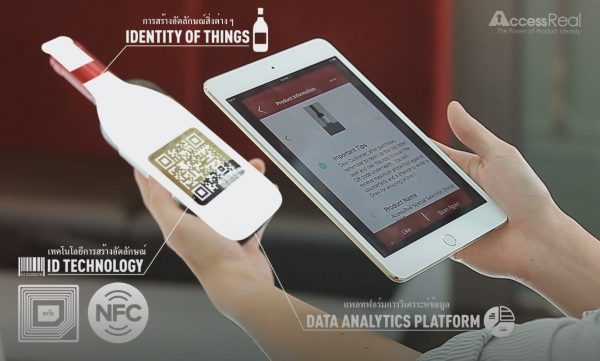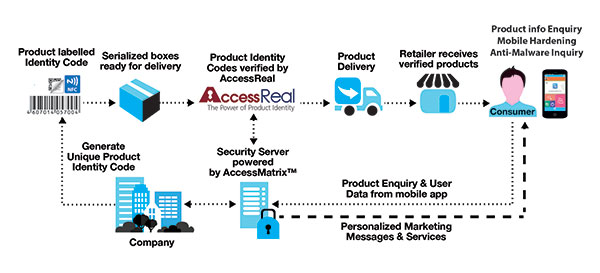$1.77 trillion was lost to counterfeit and pirated goods globally in 2015, according to an estimate issued by the International Chamber of Commerce (ICC). Besides, brands suffer from negative impacts such as brand image damage and loss of customer confidence due to lower customer satisfaction and consumer health hazards from inferior counterfeit and pirated products.
The proliferation of e-commerce has forced brand owners to look beyond traditional brick-and-mortar stores for cost-effective means to reach out to more customers; however, brand owners’ control of the distribution channels for their products is being seriously challenged due to the same reason. Therefore, to overcome these challenges, a manufacturer or brand owner should tap on the right technology to provide their consumers with a tool for confirming the authenticity of their purchase anytime and anywhere. According to MarketsandMarkets, more manufacturing companies are using anti-counterfeiting technologies; it is predicted the global anti-counterfeit packaging market size will reach $153.95 billion by 2020 from $82.05 billion in 2015.
“Digital identity technology is reshaping the landscaping of anti-counterfeiting solutions,” says Mr. Ivan Lee, Business Strategy Director of i-Sprint Innovations, a recognized worldwide leader in Identity and Access Management technologies. “Leveraging different form factors such as QR code, RFID, memory tag, a unique identity can be applied to every single product. Just like the case of a human, a secured identity assures that a product’s information such as manufacturer, ingredients, date of production, expiry date, is accurate and its life cycle can thus be properly tracked. On the other hand, companies should evaluate and choose a solution that not only provides an anti-counterfeiting or a traceability capability; it should also look at how the same solution may be used to engage their customers directly and generate valuable market insights.”
Key criteria for choosing the right solution with anti-counterfeiting and/or anti-diversion features
The product can be reliably authenticated without causing further ambiguity
Consumers do not need to have special knowledge or tool to authenticate a product. It must be easy and quick to use. E.g. Using a mobile authentication app on the consumer’s mobile device to scan a special QR code (Note: basic QR code does NOT work reliably) to receive information and check the authenticity of the product.

The features should be easily read by various target groups using tools easily available
Naked-eye product check is not reliable and may require consumers to have good knowledge of the product to differentiate the real and fake ones. More advanced techniques like RFID tags allows only supply chain dealers or special customs authority with the professional equipment to verify a goods’ true identity. Not all products have to be verified at every stage in the supply chain right through to the end customer. As a matter of fact, enabling end customers brings much more value for truly committed brand owners. Semi-overt features like 2-layer linear or matrix codes that can be read by smartphones are ideal in this respect.
The features have tamper-evident or void evident effect
Examples like wine and spirit bottles are subject to the danger that the packaging or bottle will be collected and reused by counterfeiters. There exists an even bigger risk if products are disposed of in large quantities after use, like in the case of medication containers in hospitals. To counter the risk, special sealing techniques and special materials on the coating or the label itself could be used to create a tamper-evident effect when the product is first opened.
Adopting the features is non-disruptive to a manufacturer’s existing production process. The manufacturer can integrate with its existing platform
Ideally, brand manufacturers do not need to change their production processes in such a circumstance; they could incorporate the solution into their production processes easily.
Adopting the feature should be incorporated well into the existing supply chain and retail environment
Examples like wine and spirit bottles are subject to the danger that the packaging or bottle will be collected and reused by counterfeiters. There exists an even bigger risk if products are disposed of in large quantities after use, like in the case of medication containers in hospitals. To counter the risk, special sealing techniques and special materials on the coating or the label itself could be used to create a tamper-evident effect when the product is first opened.

Real-Time data for business decision
The ability to provide a unique identity code for each product could create a vast amount of business intelligence for the company. The company can track the movement of every individual product along the channel. Real-time information such as locations spotted with counterfeit activities, the performance of channel moving the stock. All these can become valuable tools for making informed business decisions.

Partnering with a solution provider with a significant regional presence and knowledge
Partners with a significant presence in a region could also help seek support from local groups and endorsements from local authorities. Your partner should also know well how to tailor the solution for local use habits. The more consumers are using the anti-counterfeiting tool, the more confidence they will have when buying your products. Likewise, when a product is selling in multiple markets, an ideal partner should have strong international exposure.
Reference:
International Chamber of Commerce / BASCAP, Estimating the Global Economic and Social Impacts of Counterfeiting and Piracy (2011)
MarketsandMarkets, Anti-Counterfeit Packaging Market by Technology – Global Forecasts to 2020 (February 2016)
